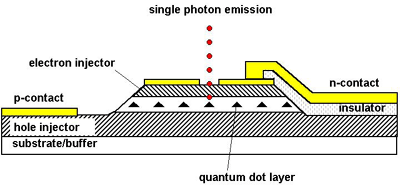The first practical electrically driven single-photon generator could play a key role in the emerging technologies of quantum cryptography and quantum computing. Andrew Shields of Toshiba Research Europe in Cambridge and colleagues at Toshiba and the University of Cambridge added a layer of ‘quantum dots’ to a conventional light-emitting diode to create their device, which could also be used for extremely sensitive optical experiments (Zhiliang Yuan et al 2001 Science to appear).

Quantum dots are nano-sized deposits of one semiconductor embedded in another semiconductor. The dot material has an energy bandgap that is smaller than that of the surrounding material, and this allows it to trap charge carriers.
Shields and colleagues deposited an array of indium arsenide quantum dots in a layer of undoped gallium arsenide, which they sandwiched between layers of hole- and electron-doped gallium arsenide. The team then applied voltage pulses across the structure.
These pulses force positive holes from the hole-doped layer and electrons from the electron-doped layer into the undoped layer, which contains the quantum dots. Due to its low potential energy, each quantum dot can capture a hole and an electron, and these combine to produce a single photon. A tiny aperture on top of the device allows photons from just one of the quantum dots to escape.
Shields and co-workers designed their generator to emit infrared photons, which corresponded to the sensitive region of their single-photon counter. But according to the team, the quantum dots can be tuned to emit light at a range of wavelengths, including 1.3 micrometres – the wavelength used in fibre optic communications. Dots that generate photons with longer wavelengths are also efficient above 5 kelvin, the temperature at which the current device operates.
Until now, single-photon generators have been driven by lasers, and this makes them bulky and impractical. Previous devices that were electrically driven only worked at millikelvin temperatures.
“A single photon source is a building block for a wide range of applications in quantum information technology, of which secure optical communications is the most immediate”, says Shields. “In the future we may see that quantum effects enable many new optical technologies, rather like the laser did a few decades ago”.



